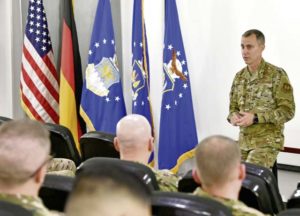
The U.S. Air Forces in Europe and Air Forces Africa mission is best executed when Airmen are developed and cared for, and the new USAFE-AFAFRICA command chief is here to ensure Airmen can rise to the challenge.
“I am honored and humbled for the opportunity to be here in USAFE -AFAFRICA, and I am excited to serve the Airmen in this capacity,” said Chief Master Sgt. Brion Blais, who became the command chief in July.
As the air component for U.S. European Command and Africa Command, more than 35,000 Airmen work around-the-clock to support the USAFE-AFAFRICA mission. They provide the Air Force’s full-spectrum warfighting capabilities to forward-based airpower and infrastructure in order to conduct and enable theater and global operations.
The 25-year veteran is also the senior enlisted advisor to the commander on all matters affecting operations, training and readiness, health, morale and welfare, discipline, and effective use of total force personnel assigned to eight wings and 88 geographically separated units across 104 countries.
“Here, we have an in-place and force projection mission,” Blais said. “We send Airmen forward throughout EUCOM and AFRICOM areas of responsibility to support operations and exercises, train GSUs and even provide support to Air Force Central Command when requested.”
As USAFE-AFAFRICA continues to evolve, Blais has a deliberate plan for developing the force across the command.
“I want to build upon professional development venues, while ensuring we do not lose focus on functional development. This is about Airmen that can step in and out of leadership or followership roles, while working with diverse teams to accomplish increasingly more challenging problems,” he said. “We are the most lethal and ready force on the face of the planet, but we must continue to hone our skills if we want to outpace our competitors.”
Additionally, Blais said he wants to ensure Airmen are ready for 21st century warfare and are experts at their crafts.
“They have to demonstrate career and functional expertise within their skill level,” explained Blais. “They must be able to adapt to changing environments, which means they have to know their job well enough to understand what needs to be done and how to accomplish it with limited resources and communication.”
The ultimate goal for Blais is to focus on empowering the workforce within the command.
“Airmen need to feel they have the trust and authority from their leadership to get after and do what they are trained for,” he said. “A huge part of empowering people is knowing their leadership is going to support them when they make decisions.”
Part of the command’s mission is to stand ready to deliver combat power anywhere in the world, at any time.
“Our Airmen have a big piece of that and we are at the tip of the spear in this area of operations,” Blais said. “I want to ensure that Airmen have the resources they need and the expertise required to execute their mission here and now.”
Since he enlisted in 1994, each tier of the enlisted structure has helped shape Blais into the leader he is today. From the noncommissioned officer tier where he grew personally to the senior NCO tier where he learned to focus more on mission accomplishment, each tier was formative to where he is now.
But he could not have succeeded without his mentors who both guided and set the example for him.
One of his strongest mentorship moments came when he was at Malmstrom Air Force Base, Montana, where he became a flight chief for the first time.
“My supervisor, Col. Timothy Dodge, piled on the responsibility, but it came with trust,” recalled Blais. “It’s where I learned what empowerment really looks like; I would not have failed him for anything.”
A couple assignments later, now-Maj. Gen. Tom Miller, hired Blais for his first command chief position at Kirkland AFB, New Mexico, in 2015.
“When I stepped into the role of command chief, I learned that I no longer identified with one career field. I had to be agnostic and my team was ‘All Airmen,’” said Blais. “I had to broaden my perspective and make sure I was taking care of everything and not just the enlisted Airmen who wear the uniform, but our officer corps, and the civil service Airmen and the families.”
When it comes to enlisted Airmen, too many are trying to “check the boxes” and striving to be what they think the “perfect” Airman is supposed to be like, he said.
“We need Airmen to be a better version of themselves,” the chief said. “Diversity of thought, background and experience can only be considered strengths for an organization when we leverage those differences.”
At times, being an Airman can be likened to being on a sports team.
“There is no possible way I would have been successful in any of my positions from flight chief to where I am now if I had not either been part of or built a winning team,” he said. “Being a team player means caring about all of your teammates and making your collective success the goal; we win together, not at the expense of our teammates.”
Regardless of where Blais sits in an organization, he said he is still the same person as when he joined.
“I hope Airmen can see that I am humble, hardworking, and that I truly care about getting the mission done right while taking care of Airmen and their families,” said Blais.


